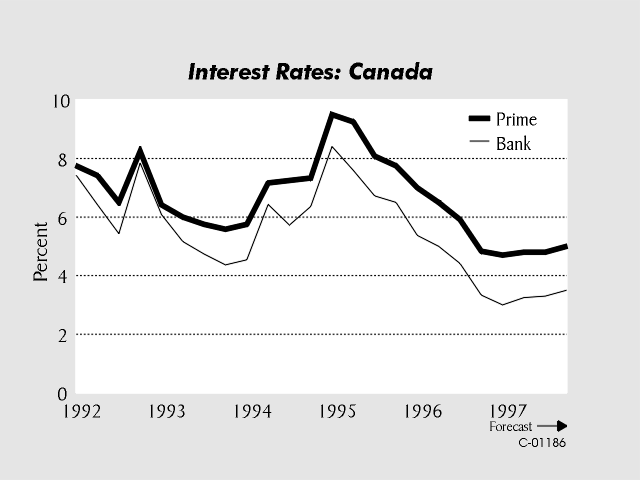
The Canadian economy experienced further structural changes in 1996 as businesses reorganized to meet market changes brought on by increased global competition and technological advances. Governments continued dealing with their deficit problems through spending reductions and public sector layoffs. The end result was a slow growing economy with employment gains in the private sector being offset somewhat by losses in the public sector.
There were, however, several positive developments last year which have created a very favourable economic climate for 1997. Inflation moved back to the 1-2 percent range, remaining low for the fifth consecutive year. The current account (what we pay out to foreigners less what we receive from them) moved very close to being balanced as a rapidly expanding merchandise trade balance nearly offset chronic deficits on services trade and net investment income. As well, public sector borrowing continued to decrease and the issue of Quebec separation was no longer at the forefront of financial market concerns.
Interest Rates
All of the above factors increased financial market confidence in the Canadian economy last year and put upward pressure on the dollar. With the dollar no longer needing high interest rates to support it, the Bank of Canada gained more monetary flexibility and was better able to respond to domestic fundamentals (i.e., low inflation, declining government borrowing, and significant excess capacity) which had warranted significant monetary easing for sometime. As a result short-term interest rates fell dramatically.
Since 1992 employment gains have been disappointing, especially when compared to past economic recoveries. In 1997 employment growth is expected to improve relative to 1996 as significant job creation in the private sector more than offsets further public sector contraction. An abundance of people ready to join the labour market as employment prospects improve means the unemployment rate will probably decline slowly.
National Outlook
Stronger employment and personal income growth together with low interest rates and pent-up consumer demand should accelerate the domestic side of the economy in 1997. Interest rates are expected to remain low, especially relative to recent years, as low inflation, falling government deficits, and a current account surplus all help maintain and/or increase financial market confidence in Canada. These factors are also expected to put upward pressure on the dollar for the next couple of years. Increased consumer spending and further growth in housing and business investment should result in healthy and balanced GDP growth of roughly 3.0 percent.
A competitive export sector together with a stable economic expansion in the G-7 countries and further reductions in tariffs under the World Trade Organization and NAFTA should ensure continued but more moderate growth in exports.
Main Page Contents Next Section